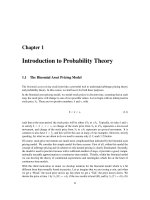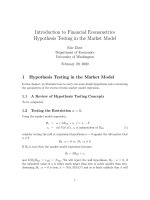INTRODUCTION TO ELECTROPHORESIS
Bạn đang xem bản rút gọn của tài liệu. Xem và tải ngay bản đầy đủ của tài liệu tại đây (2.15 MB, 52 trang )
INTRODUCTION TO ELECTROPHORESIS
INTRODUCTION TO ELECTROPHORESIS
Electrophoresis
•
Electrophoresis is a method whereby charged molecules in solution, chiefly proteins and nucleic
acids, migrate in response to an electrical field.
•
Their rate of migration through the electrical field, depends on the strength of the field, on the
net charge, size, and shape of the molecules, and also on the ionic strength, viscosity, and
temperature of the medium in which the molecules are moving.
•
As an analytical tool, electrophoresis is simple, rapid and highly sensitive.
•
It can be used analytically to study the properties of a single charged species or mixtures of
molecules. It can also be used preparatively as a separating technique
Electrophoresis
•
Electrophoresis is usually done with gels formed in tubes, slabs,
or on a flat bed.
•
In many electrophoresis units, the gel is mounted between two
buffer chambers containing separate electrodes, so that the only
electrical connection between the two chambers is through the
gel.
In most electrophoresis units, the gel is mounted between two
buffer chambers containing separate electrodes so that the
only electrical connection between the two chambers is through
the gel.
The Technique
The Technique
Tube Gel Units
Slab Gel Units
Slab Gel Unit
Slab Gel Unit
Flat Bed Unit
Interrelation of Resistance,
Voltage, Current and Power
◆
Two basic electrical equations are important in electrophoresis
–
The first is Ohm's Law, I = E/R
–
The second is P = EI
–
This can also be expressed as P = I
2
R
◆
In electrophoresis, one electrical parameter, either current, voltage, or
power, is always held constant
Consequences
◆
Under constant current conditions (velocity is directly proportional to
current), the velocity of the molecules is maintained, but heat is
generated.
◆
Under constant voltage conditions, the velocity slows, but no additional
heat is generated during the course of the run
◆
Under constant power conditions, the velocity slows but heating is kept
constant
The Net Charge is Determined
by the pH of the Medium
◆
Proteins are amphoteric compounds, that is, they contain both acidic and
basic residues
◆
Each protein has its own characteristic charge properties depending on the
number and kinds of amino acids carrying amino or carboxyl groups
◆
Nucleic acids, unlike proteins, are not amphoteric. They remain negative at
any pH used for electrophoresis
Temperature and Electrophoresis
◆
Important at every stage of electrophoresis
– During Polymerization
» Exothermic Reaction
»
Gel irregularities
» Pore size
– During Electrophoresis
» Denaturation of proteins
» Smile effect
»
Temperature Regulation of Buffers
What is the Role of the Solid
Support Matrix?
◆
It inhibits convection and diffusion, which would otherwise impede
separation of molecules
◆
It allows a permanent record of results through staining after run
◆
It can provide additional separation through molecular sieving
Agarose and Polyacrylamide
◆
Although agarose and polyacrylamide differ greatly in their physical and
chemical structures, they both make porous gels.
◆
A porous gel acts as a sieve by retarding or, in some cases, by completely
obstructing the movement of macromolecules while allowing smaller
molecules to migrate freely.
◆
By preparing a gel with a restrictive pore size, the operator can take
advantage of molecular size differences among proteins
Agarose and Polyacrylamide
◆
Because the pores of an agarose gel are large, agarose is used to separate
macromolecules such as nucleic acids, large proteins and protein complexes
◆
Polyacrylamide, which makes a small pore gel, is used to separate most
proteins and small oligonucleotides.
◆
Both are relatively electrically neutral
Agarose Gels
◆
Agarose is a highly purified uncharged polysaccharide derived from agar
◆
Agarose dissolves when added to boiling liquid. It remains in a liquid state until
the temperature is lowered to about 40° C at which point it gels
◆
The pore size may be predetermined by adjusting the concentration of agarose
in the gel
◆
Agarose gels are fragile, however. They are actually hydrocolloids, and they are
held together by the formation of weak hydrogen and hydrophobic bonds
Structure of the Repeating Unit of
Agarose, 3,6-anhydro-L-galactose
Basic
disaccharide
repeating units of
agarose,
G: 1,3-β-d-
galactose
and
A: 1,4-α-l-3,6-
anhydrogalactose
Gel Structure of Agarose
Polyacrylamide Gels
◆
Polyacrylamide gels are tougher than agarose gels
◆
Acrylamide monomers polymerize into long chains that are covalently linked by a
crosslinker
◆
Polyacrylamide is chemically complex, as is the production and use of the gel
Crosslinking Acrylamide Chains
Considerations with PAGE
◆
Preparing and Pouring Gels
– Determine pore size
» Adjust total percentage of acrylamide
» Vary amount of crosslinker
–
Remove oxygen from mixture
– Initiate polymerization
» Chemical method
» Photochemical method
Considerations with PAGE
◆
Analysis of Gel
– Staining or autoradiography followed by
densitometry
– Blotting to a membrane, either by
capillarity or by electrophoresis, for
nucleic acid hybridization,
autoradiography or immunodetection
![[CEH V3] Introduction to Ethical Hacking](https://media.store123doc.com/images/document/13/ly/ap/medium_3ABUW8WdDH.jpg)








